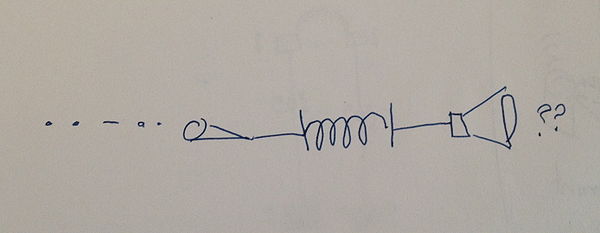Jeff Rowell 250B
Jeffrey Rowell-Reverberant Art
"Keeping Time"- Pendulum Guitar
The project is a set of coupled pendulums with mounted electromagnetic pickups set in front of a semi-hollow electric guitar. The guitar has a mounted transducer attached to the soundboard on the back of the guitar and is playing several simultaneous frequency sweeps to induce vibrations in the strings, which are then detected in the pickups and played through a small amplifier on the ground below the installation.
Elements-
1)Guitar- A red Ibanez Artcore AS73 has been selected. The transducer and an iPod shuffle playing the filter sweeps can be satisfactorily mounted on the back opposite the bridge and used to induce constant sound but shifting sympathetic vibration from the strings.
2)Pendulums- Two pendulums must be built, spaced next to each other. They will be placed so that their neutral position is over the high and low strings; this is approximately two and a half inches, so to allow free motion the bottom of one of the pendulum features an offset split structure that allows the pendulums to freely swing through each other.
3)Mounting- The installation will be wall mounted, with the mounting supporting the pendulums and guitar, and the amplifier set below on the floor.
4)Presentation- Ideally, the body of the guitar will be mounted around 4.5 feet off the ground, where the pendulums are easily touched but the headstock is uncomfortably high to reach. It should be lit with a spot from above to highlight the changing shadows as the pendulums move.
Preliminary Project Ideas
1)Selectable Spring Reverb
Two soundboards with high tension springs between them with a controllable damper on each spring. One sound is input on one side and picked up on the other with variable amounts of reverb. The control system would be a set of foot pedals/switches similar to organ foot pedals which would raise dampers off springs to allow them to transmit sound.
2)Variable Reverb Room
A room with a microphone and moveable walls/ceiling which would analyze the pitch of voices within it and attempt to change the shape of the room to highlight harmonics in the voice.
3)Morse code through Spring Reverb
Sending Morse Code through reverb and then attempting decoding, explore the chaotic mistranslations that would occur given significant signal distortion.
4)Coupled Pendulum Pickups
A pair of guitar pickups are mounted on a set of coupled pendulums, and then set in front of two strings vibrating at close but different frequencies. The output of the pickups is then fed into a loudspeaker mounted close behind the system for feedback.
This is my favorite concept currently due to the combination of simple concepts and extremely complicated output.
5)Clocking output through variable pendulum.
A spring pendulum, such that the movement of the spring changes the center of mass of the pendulum and modulates the period. This would create a system linking the visual distortion of time and the audio distortion of time.
6)Distortion of Visual projection by Reverb
7) Wire over Ferrofluid
A wire suspended over ferrofluid, with a current applied based on the output of a set of speakers. The gain on the sound sources is then controlled by the tension on the wire, such that the increase in ferrofluid weight on the wire lowers the gain. This would create a reactive loop of (increase in fluid weight)->(lowering of gain)->(lowering of wire current)->(decrease in fluid weight on wire). Depending on the latency of the system, convergent, divergent or stable systems could be created.
8) Ferrofluid reverberation tracker (most idea credit to Eoin)
Ferrofluid held on a small powerful magnet forms a nice spiky mushroom shape, which is responsive to both motion and wind pressure. A few of these mounted in the ports of subwoofers would create a cool visualization of sounds run through the woofer, as well as pressure changes in the room caused by motion and door openings.



